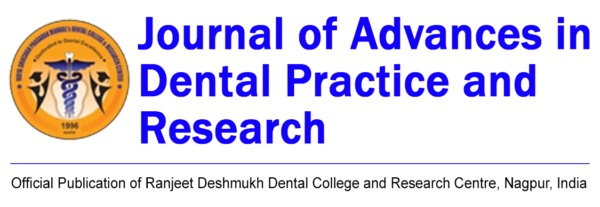Translate this page into:
Evaluation of efficacy of a training module regarding biohazards associated with materials used in prosthodontics for dental students – A cross-sectional study
*Corresponding author: Pranali Dilip Malekar, Department of Prosthodontics, Ranjeet Deshmukh Dental College and Research Centre, Nagpur, Maharashtra, India. pranali.malekar1998@gmail.com
-
Received: ,
Accepted: ,
How to cite this article: Malekar PD, Deshpande S. Evaluation of efficacy of a training module regarding biohazards associated with materials used in prosthodontics for dental students – A cross-sectional study. J Adv Dental Pract Res. 2024;3:2-6. doi: 10.25259/JADPR_12_2024
Abstract
Objectives:
This study aimed to evaluate the efficacy of a training module for dental students on biohazards associated with dental materials.
Material and Methods:
Single group pre- and post-test design was used. One hundred undergraduate dental students were enrolled. Ninety-two students responded to the questionnaire.
Results:
Post-test score improved significantly after the session.
Conclusion:
There was an improvement in the knowledge regarding various aspects of biohazards as a result of this module.
Keywords
Biohazards
Ergonomic hazard
Chemical hazard
Dental materials
INTRODUCTION
A hazard can be defined as a source of potential damage, harm, or adverse health effects on something or someone at work. Biological hazards are biological agents that can cause harm to the human body.[1]
Prosthodontic practice requires contact with restorative and auxiliary dental materials of widely different compositions, such as metals, resin-based synthetic polymers, cement, and impression materials, and restorative materials,such as dental amalgam, composites, and dental ceramics.[2] Prosthodontic hazards may affect the patient, the dentist, the dental laboratory technician, or the dental assistant.[3]
The potential risk of irritant chemicals, inhalation of vapors, dust particles, and injury from high-speed rotary equipment and flammable materials always exists in prosthodontic practice. The students need to be aware of all the hazards and protective measures to avoid them.[4]
Therefore, this cross-sectional study was conducted to evaluate the efficacy of a training module regarding biohazards associated with materials used in prosthodontics for dental students.
Aims and objective
The objective of this study was to evaluate the efficacy of a training module regarding biohazards associated with materials used in prosthodontics for dental students.
MATERIAL AND METHODS
Approval from the Institutional Ethics Committee of Ranjeet Deshmukh Dental College and Research centre, Nagpur was obtained. IEC/VSPMDCRC/46/2021, dated 17th February 2021.
Study design
This study was a cross-sectional study with pre-post-design.
Study sample
One hundred undergraduate dental students were enrolled. Ninety-two students responded to the questionnaire.
Steps
The first section includes student’s demographic data and the second section includes a pre-validated questionnaire. A pre-validated questionnaire is developed and validated for checking the knowledge of students regarding biohazards of dental materials in multiple-choice, Likert scale, and open-ended format. This self-administered questionnaire was shared in the form of a Google form and the link was shared on the respective WhatsApp group of students.
The steps in conducting this investigation are as follows:
Recording pre-test scores using a questionnaire
Conducting training modules on biohazards and their prevention using didactic lectures as well as demonstration
Recording post-test scores using the same questionnaire.
RESULTS
Statistical Software: IBM SPSS 2020
Tools: Descriptive statistics was expressed in terms of frequencies and percentages. McNemar test was used to test the significant difference between pre-test and post-test responses. Results are depicted in Figures 1-10 and Table 1.
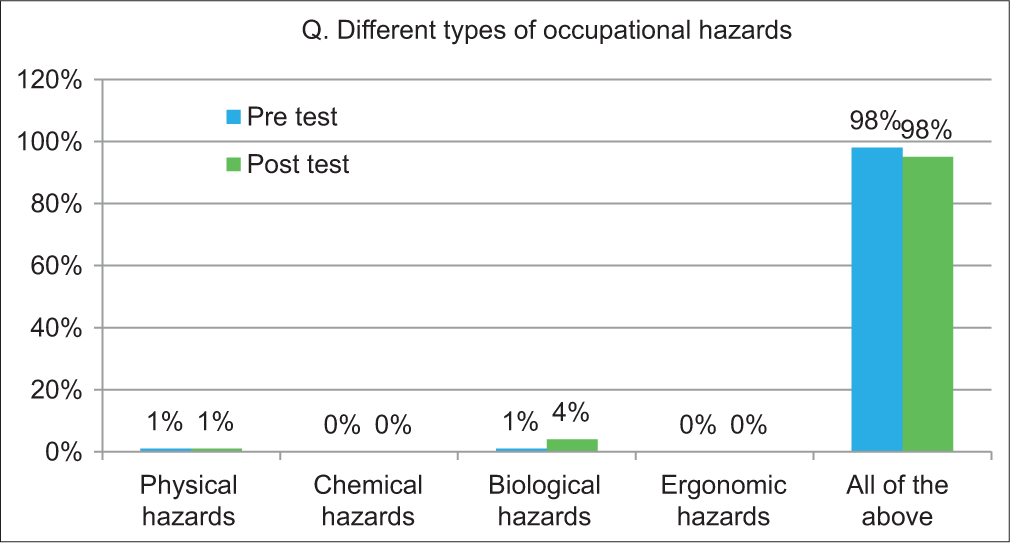
- About 98% students were well aware about various types of occupational hazards in both the tests.
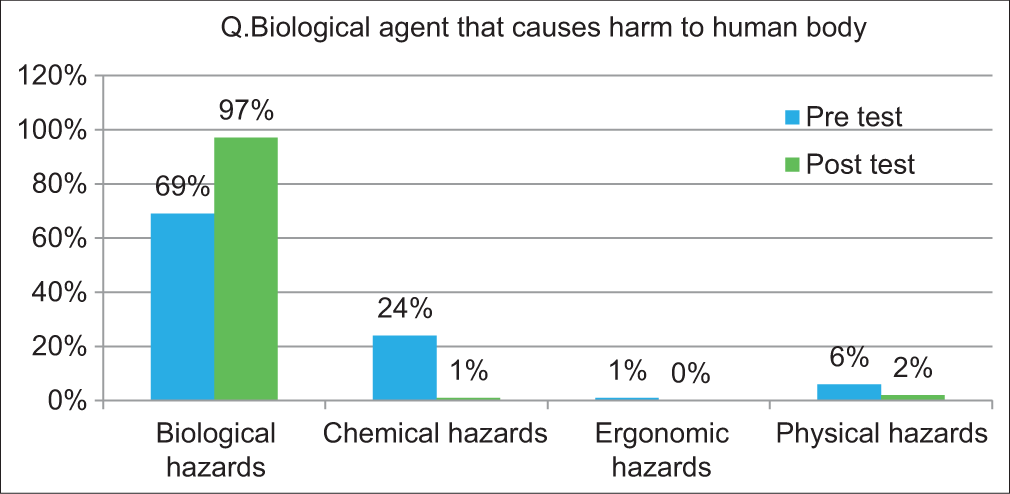
- About 69% students were correct in the pretest but the result improved to 97% in the post-test and the P value is significant.
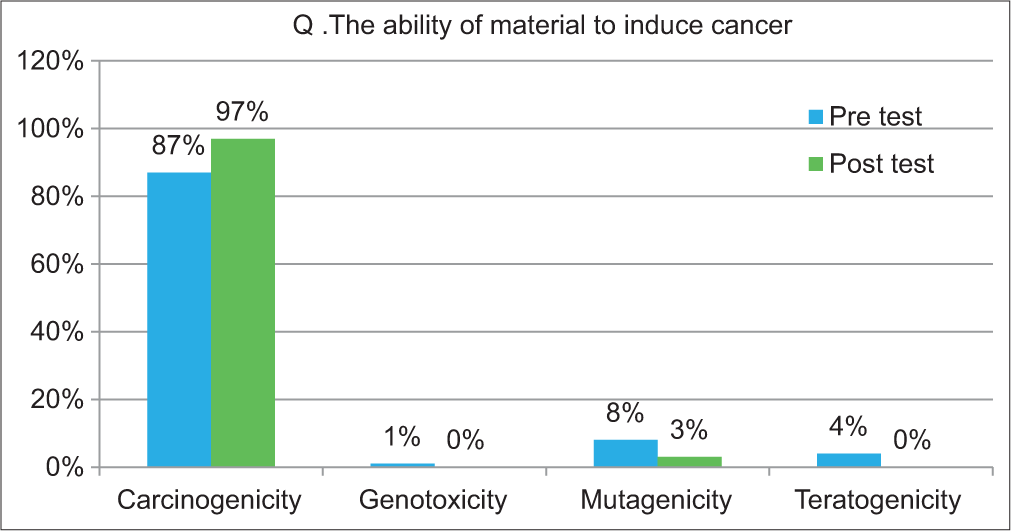
- About 87% students were correct in pre-test and result improved by 10% in post-test to 97%.
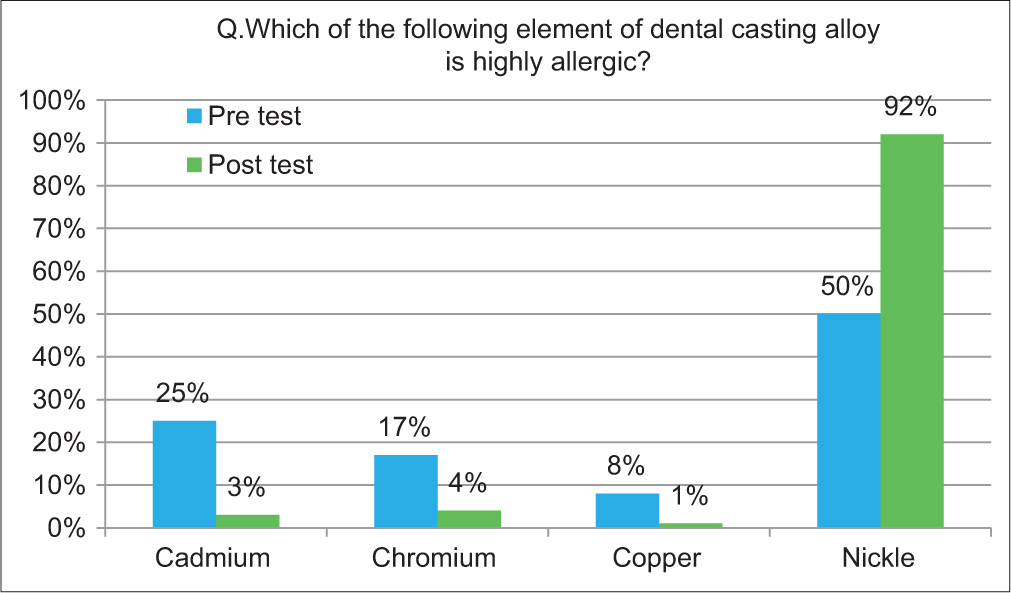
- About 50% students gave incorrect answer in pretest and result improved by 42% in post-test to 92% and P value is significant.
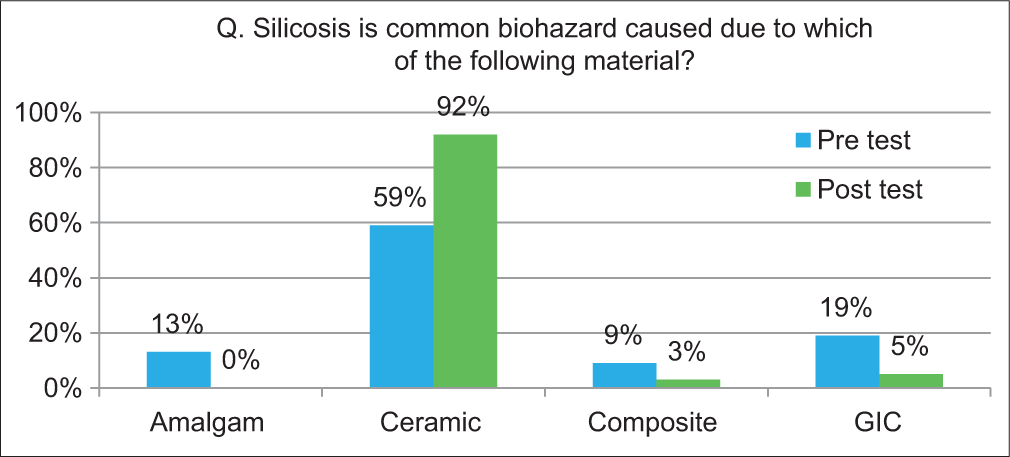
- About 59% students gave correct answer in pre-test and value improved in post-test by 92%. GIC: Glass ionomer cement
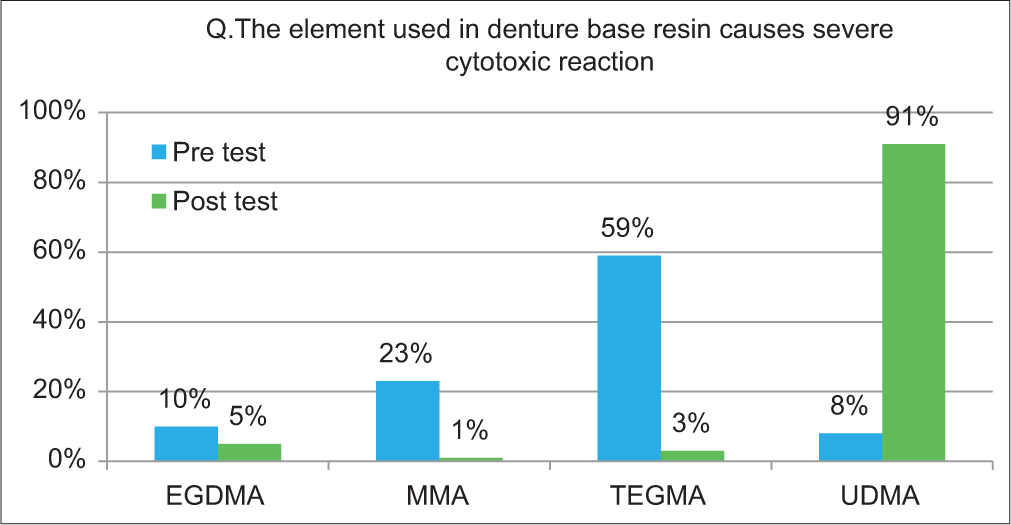
- About 92% students gave incorrect answer in the pre-test and result improved significantly 91% student gave correct answer in their post-test. EGDMA: Ethylene glycol dimethylacrylate, MMA: methylmethacrylate, TEGMA: Triethylene glycol dimethacrylate, UDMA: Urethane dimethacrylate
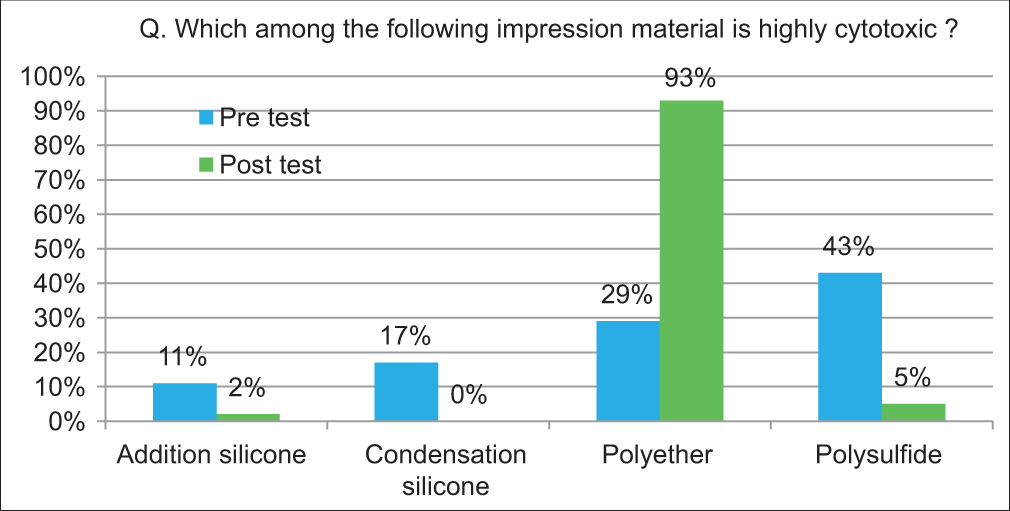
- Pretest only 29% students were correct and result improved to 93% in post-test.
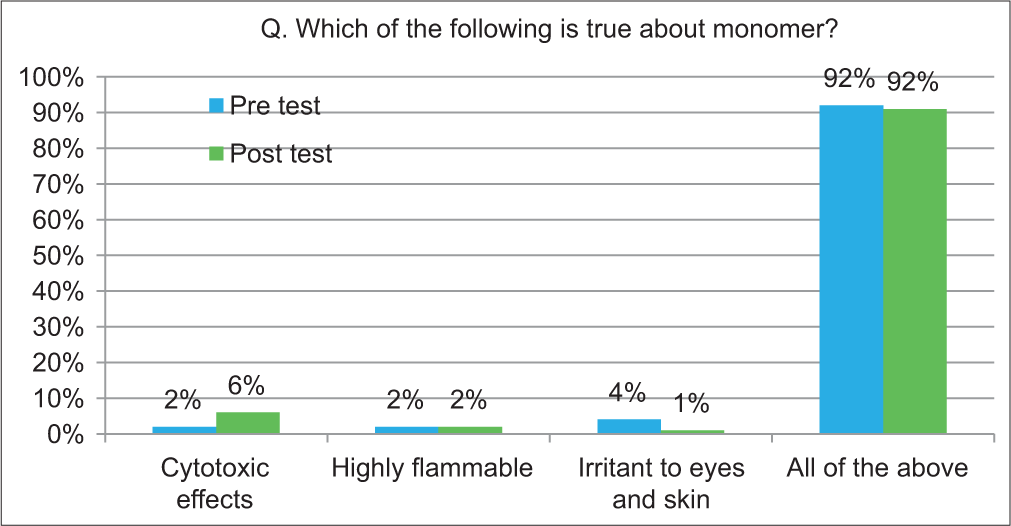
- About 52% students were correct in the pre-test and result improved by 89% in the post-test.
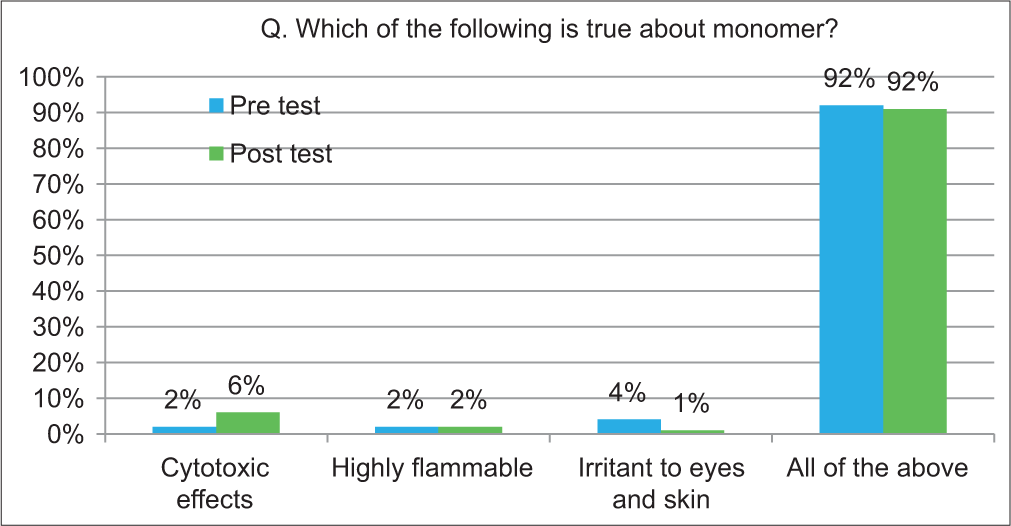
- Got similar result in both pre- and post-test.
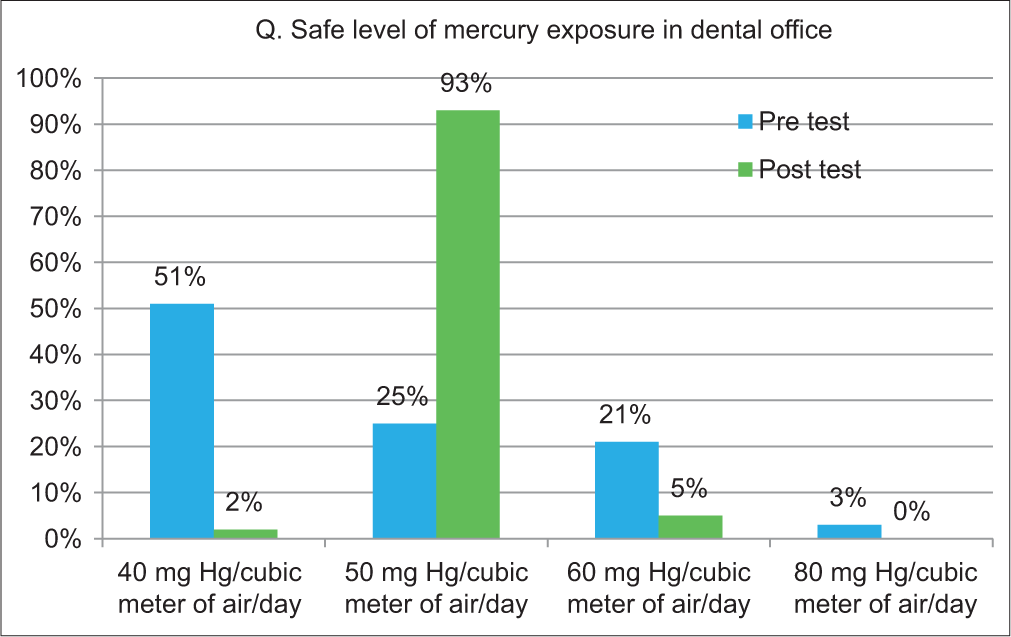
- In pre-test score was very less as it is a factual question but score increased significantly to 93%.
| Categories | Pre test | Post test | P-value | ||
|---|---|---|---|---|---|
| Frequency | Percentage | Frequency | Percentage | ||
| Are you aware about biohazards caused by various dental materials? | |||||
| No | 4 | 4 | 16 | 16 | |
| Not sure | 6 | 6 | 10 | 10 | |
| Yes | 90 | 90 | 74 | 74 | |
| Have you ever experienced any biohazard (e.g., allergic reaction) in your pre-clinical practice? | |||||
| No | 73 | 73 | 54 | 54 | |
| Not sure | 4 | 4 | 20 | 20 | |
| Yes | 23 | 23 | 26 | 26 | |
| I feel confident while using various dental materials? | |||||
| Strongly agree | 10 | 10 | 24 | 24 | |
| Agree | 78 | 78 | 63 | 63 | |
| Strongly disagree | 0 | 0 | 8 | 8 | |
| Disagree | 12 | 12 | 5 | 5 | |
| There should be special emphasis on biohazards during regular teaching-learning and assessment? | |||||
| Strongly agree | 56 | 56 | 47 | 47 | |
| Agree | 43 | 43 | 38 | 38 | |
| Can’t say | 1 | 1 | 13 | 13 | |
| Disagree | 0 | 0 | 2 | 2 | |
| What are the different types of occupational hazards? | |||||
| Physical hazards | 1 | 1 | 1 | 1 | 0.000** |
| Biological hazards | 1 | 1 | 4 | 4 | |
| All of the above | 98 | 98 | 95 | 98 | |
| Biological agent that causes harm to human body are | |||||
| Biological hazards | 69 | 69 | 97 | 97 | 0.000** |
| Chemical hazards | 24 | 24 | 1 | 1 | |
| Ergonomic hazards | 1 | 1 | 0 | 0 | |
| Physical hazards | 6 | 6 | 2 | 2 | |
| The ability of material to induce cancer is | |||||
| Carcinogenicity | 87 | 87 | 97 | 97 | 0.022* |
| Genotoxicity | 1 | 1 | 0 | 0 | |
| Mutagenicity | 8 | 8 | 3 | 3 | |
| Teratogenicity | 4 | 4 | 0 | 0 | |
| Which of the following elements of dental casting alloy is highly allergic? | |||||
| Cadmium | 25 | 25 | 3 | 3 | 0.000** |
| Chromium | 17 | 17 | 4 | 4 | |
| Copper | 8 | 8 | 1 | 1 | |
| Nickel | 50 | 50 | 92 | 92 | |
| Silicosis is a common biohazard caused due to which of the following materials? | |||||
| Amalgam | 13 | 13 | 0 | 0 | 0.000** |
| Ceramic | 59 | 59 | 92 | 92 | |
| Composite | 9 | 9 | 3 | 3 | |
| Glass Ionomer Cement | 19 | 19 | 5 | 5 | |
| Which element used in denture base resin causes a severe cytotoxic reaction? | |||||
| Ethylene glycol dimethylacrylate | 10 | 10 | 5 | 5 | 0.000** |
| Methylmethacrylate | 23 | 23 | 1 | 1 | |
| Triethylene glycol dimethacrylate | 59 | 59 | 3 | 3 | |
| Urethane dimethacrylate | 8 | 8 | 91 | 91 | |
| Which among the following impression materials is highly cytotoxic? | |||||
| Addition silicone | 11 | 11 | 2 | 2 | 0.000** |
| Condensation silicone | 17 | 17 | 0 | 0 | |
| Polyether | 29 | 29 | 93 | 93 | |
| Polysulfide | 43 | 43 | 5 | 5 | |
| Most common route of entry of mercury vapor is | |||||
| Both “a” and “b” | 37 | 37 | 9 | 9 | 0.000** |
| Ingestion | 9 | 9 | 2 | 2 | |
| Inhalation | 52 | 52 | 89 | 89 | |
| Skin | 2 | 2 | 0 | 0 | |
| Which of the following is true about monomers? | |||||
| Cytotoxic effects | 2 | 2 | 6 | 6 | 0.998 |
| Highly flammable | 2 | 2 | 2 | 2 | |
| Irritant to eyes and skin | 4 | 4 | 1 | 1 | |
| All of the above | 92 | 92 | 91 | 91 | |
| Safe level of mercury exposure in dental office is | |||||
| 40 mg Hg/cubic meter of air/day | 51 | 51 | 2 | 2 | 0.000** |
| 50 mg Hg/cubic meter of air/day | 25 | 25 | 93 | 93 | |
| 60 mg Hg/cubic meter of air/day | 21 | 21 | 5 | 5 | |
| 80 mg Hg/cubic meter of air/day | 3 | 3 | 0 | 0 | |
Bold values: *significant (P<0.05), **highly significant (P<0.01)
DISCUSSION
There are various types of occupational hazards, namely, physical hazards, chemical hazards, biological hazards, and ergonomic hazards. It is important for the students to be aware regarding the same so that their deleterious effects can be prevented.[5-10] Thus, we conducted this study for evaluation of efficacy of a training module regarding biohazards associated with materials used in prosthodontics for dental students. A pre-test was conducted. A comprehensive didactic session was conducted, followed by post-test. Results of both the tests were compared. The majority of students became aware of biohazards caused by various dental materials after the session, and results improved significantly in post-test. Many students acknowledged the importance of knowledge about biohazards and relevant precautionary measures to avoid them in routine practice.
CONCLUSION
This module was effective in improving the understanding of the students regarding various biohazards and strategies to overcome the same.
Ethical approval
The research/study is approved by the Institutional Ethics Committee at Ranjeet Deshmukh Dental College and Research centre, Nagpur, number IEC/VSPMDCRC/46/2021, dated 17th February 2021.
Declaration of patient consent
Patient’s consent not required as there are no patients in this study.
Conflicts of interest
Dr. Saee Deshpande is on the Editorial Board of the Journal.
Use of artificial intelligence (AI)-assisted technology for manuscript preparation
The authors confirm that there was no use of artificial intelligence (AI)-assisted technology for assisting in the writing or editing of the manuscript and no images were manipulated using AI.
Financial support and sponsorship
Nil.
References
- Hazards of prosthodontic devices and materials. Tanta Dent J. 2017;14:7-11.
- [CrossRef] [Google Scholar]
- Biohazards associated with materials used in prosthodontics. Niger J Clin Pract. 2013;16:139-44.
- [CrossRef] [PubMed] [Google Scholar]
- Biohazards associated with the materials used in dentistry. Res J Pharm Tech. 2015;8:1048-50.
- [CrossRef] [Google Scholar]
- The current status of national reporting systems for adverse reactions to dental materials. J Dent. 2004;32:351-8.
- [CrossRef] [PubMed] [Google Scholar]
- Treatment of health complaints attributed to amalgam. J Dent Res. 2008;87:349-53.
- [CrossRef] [PubMed] [Google Scholar]
- Oral lichenoid lesions related to contact with dental materials: A literature review. Med Oral Patol Oral Cir Bucal. 2009;14:514-20.
- [CrossRef] [PubMed] [Google Scholar]
- Cytotoxic and mutagenic effects of dental composite materials. Biomaterials. 2005;26:1713-9.
- [CrossRef] [PubMed] [Google Scholar]
- Pattern of cell death after in vitro exposure to GDMA, TEGDMA, HEMA and two compomer extracts. Dent Mater. 2006;22:630-40.
- [CrossRef] [PubMed] [Google Scholar]
